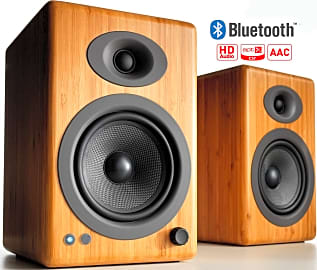The 8 Best Bamboo Speakers

This wiki has been updated 35 times since it was first published in April of 2016. What's so special about bamboo? It's a fast-growing wood that, unlike most timber, is a self-regenerating natural resource, which makes it an environmentally-friendly material for many applications. Plus, if you take a look at these speakers, you can see that it also has a lovely appearance and produces a rich sound quality for music streamed from your phone or sent from a computer. When users buy our independently chosen editorial choices, we may earn commissions to help fund the Wiki.
Editor's Notes
May 05, 2020:
It was important to us that we include models that actually have bamboo housings wherever possible, and not just be dressed up to look like bamboo. That's why we sent off the likes of the House of Marley Chant Mini and the Aomais Life, the former of which used MDF and the latter of which used artificial bamboo. Exceptions to this agenda only came from models that proved themselves to sound outstanding while sporting a bamboo style exterior, like the Fluance Two-Way with its remote EQ adjustments and clear silk tweeters.
Of course, there were still plenty of genuine bamboo models to choose from, and we updated the Audioengine A5+ to its Bluetooth version to keep it as contemporary as possible. We also upgraded the Kanto YU2 to the Kanto YU6, which adds Bluetooth, an optical port, and a phono preamp to bring vinyl signals up to line level without needing a receiver.
Special Honors
Apollo Box This is a passive amplifier, meaning that there's nothing electronic about it. It's designed to hold your smartphone with its speakers facing downward so that the vibrations they create can resonate in this model's housing, which has been specifically cut and finished to provide a clear boost to your volume level. It's a simple, inexpensive way to get a little louder, and it's available in a wide array of colors. theapollobox.com
Why Choose Bamboo?
You’ll see speakers on the market made of just about any material you can imagine, from various woods and metals to plastics and rubbers.
You have more options today when it comes to buying speakers then you would’ve had at any other point in history. You’ll see speakers on the market made of just about any material you can imagine, from various woods and metals to plastics and rubbers. You’ll see speakers that work underwater, speakers that levitate, speakers that install in just about any kind of vehicle you can ride, and speakers with an endless number of other tricks and gimmicks designed to lure you into a purchase, regardless of the quality of their sound.
So, as you narrow down all of these various options, why should you choose bamboo over another type of material for the construction of your speaker? Simply put, bamboo is one of the most reliable, durable, and safest options for speaker construction. If that wasn’t enough, bamboo also has a particularly fine aesthetic value, adding a touch of class to your sound system, or to your portable Bluetooth speaker.
But what is it about bamboo that makes it such a smart choice? For starters, it’s one of the strongest woods in the world. That means that it can withstand years of heavy vibrations from pumping out your favorite tunes, and it also stands a better chance of surviving impacts then almost any other wood used in making speakers. Bamboo also has natural antimicrobial properties, which is why it’s such a popular material in the manufacturing of cutting boards.
Now, you probably won’t be preparing crudités on the side of your speaker cabinet, but those antimicrobial properties will help your speakers resist mold and mildew over the years, which comes in handy if you live in a moist climate. If you’ve ever opened up an old pair of speakers at a garage sale to make sure that all the wires were still connected, you may have found an unpleasant amount of mold and mildew waiting for you. That kind of degradation is much less likely to occur with a bamboo speaker.
Which Bamboo Speaker Is Right For You?
Choosing a bamboo speaker or speakers set, you’re likely to be confronted with a lot of different configurations. Knowing exactly what you want to use your speaker or speakers for will go along way toward narrowing down our list to a few great options.
Some of the models on the market, for example, are designed for portability. Most of these utilize Bluetooth connections to pair with a cell phone, tablet, or laptop, so that you can listen to your music on the go. Some of these are small enough that they can attach to a belt loop via a carabiner or comfortably be tossed into a purse or backpack. Others are designed for increased audio quality, and as such or a little bit larger. Still, the portable options on the market are universally small enough to go with you with relative ease.
Some of these are small enough that they can attach to a belt loop via a carabiner or comfortably be tossed into a purse or backpack.
Other bamboo speakers on the market are designed to be incorporated into a home stereo or theater system. These you can identify by their RCA connections, as well as the occasional traditional speaker wire clips on their backsides. By relying on hardwired connections, these speakers generally produce finer audio quality than their portable counterparts. Many also include both tweeters and woofers that combine to give you a more balanced audio profile.
Whether you’re looking at a portable or stationary model, there are a few additional features to look out for. One of the most important of these may prove to be some form of onboard equalization. If your speakers let you control things like the level of treble, mid-tone, and bass, you’ll have a better time customizing your sound without having to dive into the EQ settings on your apps or televisions, or investing in a stand-alone equalizer.
On portable models, it’s important to look out for things like battery life and charge time. Obviously the longer your battery life, the more you’ll be able to enjoy your tunes without having to recharge. And the shorter the charge time, the sooner you’ll be able to get back to listening to your tunes at full power. Stationary models don’t fall prey to power issues, but it might be worth checking the length of the power cords they come with. Even well insulated speaker wires can fall prey to interference from contact with electrical cords, so you want to find a unit with a cord that’s just the right length for your stereo set up without leaving a lot of extra slack or requiring you to add an extension cord to the mix.
A Brief History Of Bamboo
As you might assume, the use of bamboo begin in China at least 7,000 years ago. That’s the point at which we see evidence of its use in building materials, as well as the construction of tools like arrows. Interestingly, species of bamboo grow all around the world so long is the climate doesn’t get too cold, but builders and craftsman in the far east begin to use it in a variety of ways long before the rest of the world.
In more recent years, architects and manufacturers in the west have come to see bamboo as a reliable and sustainable alternative to almost any other kind of wood. That is, in part, due to bamboo’s incredible sustainability, a fact known well to Chinese and Japanese artisans dating back thousands of years. Those facts would be lost on Western minds until significant research began on the nature of the grass in the 1920s. Where a common tree harvested for its would might take up to 60 years to mature, a similar amount of bamboo might mature in as little as 60 days.
Today, bamboo products have proliferated in a wide variety of industries, giving consumers the opportunity to invest in safer, more durable materials for everything from building houses to preparing their meals at home.













